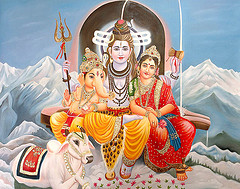|

|
|
One of the Trinity of godheads
Wedded to ‘Shakti’* with Sati* treads
Churned out poison of oceans sipped
Hence His throat is still blue stripped*.
Several His qualities, many names
For dancing skill Nataraja* claims
In spiritual innocence He astounds
Easily pleased, with boons abounds.
Smeared in ashes, He lives in trance
From His hair pile Ganges* bounce
Serpents* Him as ornaments entwine
On forehead, the curved moon shines.
Trident in one hand, in other the drum
Sits on tiger hide Nature’s spectrum
Power to destroy vilest of the vile
Truthful innocence is His profile.
Nandi Bull* always by His side
Spirituality in Him takes strides
Garland of human skulls* He wears
Metaphysics in His glance steers.
Butter soft heart in dreaded looks
Endless blessings devotee hooks
God of gods, He is Mahadeva
Innocence incarnate is Lord Shiva.
Among Hindu deities most unique
Meditates on the Himalayan peak
In temples sits as a phallic emblem
At centre under the spire as ‘lingam’*
He is the deity with the ‘third eye’*
With it, He burns all Desires awry
In fun and frolic, Bhole abounds
In His meditation He is profound.
*Shiva is 'shakti' or power, Shiva is the destroyer, the most powerful god of the Hindu pantheon and one of the godheads in the Hindu Trinity. Known by many names - Mahadeva, Mahayogi, Pashupati, Nataraja, Bhairava, Vishwanath, Bhava, Bhole Nath - Lord Shiva is perhaps the most complex of Hindu deities. Hindus recognize this by putting his shrine in the temple separate from those of other deities.
*Parvati is nominally the second consort of Shiva, the Hindu god of destruction and rejuvenation. However, she is not different from Sati, being the reincarnation of that former consort of Shiva. Parvati is the mother of the gods Ganesha and Skanda (Kartikeya). Some communities also believe her to be the sister of god Vishnu. She is also regarded as the daughter of the Himalayas. Parvati when depicted alongside Shiva appears with two arms, but when alone, she is shown having four arms, and astride a tiger or lion. Generally considered a benign goddess, Parvati also has fearful aspects like Durga, Kali, Chandi.
*Churning the ocean produced Amrit and several other precious objects. The last object to emerge was the Kalkuta poison which threatened to destroy the entire universe. Shiva drank this poison and stored it in his neck. His neck turned blue and hence he was acknowledged as Neelkanth Shiva.
*The depiction of Shiva as Nataraja is popular. The names Nartaka ("dancer") and Nityanarta ("eternal dancer") appear in the Shiva Sahasranama. His association with dance and also with music is prominent in the Puranic period. The two most common forms of the dance are the Tandava, which later came to denote the powerful and masculine dance as Kala-Mahakala associated with the destruction of the world, and Lasya, which is graceful and delicate and expresses emotions on a gentle level and is considered the feminine dance attributed to the goddess Parvati. Lasya is regarded as the female counterpart of Tandava. The Tandava-Lasya dances are associated with the destruction-creation of the world.
*Ganges: Ganga (river Ganges) is associated with Hindu mythology and is the most sacred river of Hindus. According to tradition, one who bathes in Ganga (revered as Mother Ganga) in accordance with traditional rites and ceremonies on religious occasions in combination with certain astrological events, is freed from sin and attains knowledge, purity and peace. Ganga, symbolically represented on the head of the Lord by a female (Mother Ganga) with a jet of water emanating from her mouth and falling on the ground, signifies that the Lord destroys sin, removes ignorance, and bestows knowledge, purity and peace on the devotees.
*Around his neck is a coiled serpent representing Kundalini or the spiritual energy within life.
*Nandi: the bull is associated with Shiva and is said to be His vehicle. The bull symbolizes both power and ignorance. Lord Shiva's use of the bull as a vehicle conveys the idea that He removes ignorance and bestows power of wisdom on His devotees. The bull is called Vrisha in Sanskrit. Vrisha also means dharma (righteousness). Thus a bull shown next to Shiva also indicates that He is the etemal companion of righteousness. *As the story goes, it is the garland of skulls of Parvati in her different birth representing eternal existence of Shiva.
*Shiva, in temples is usually found as a phallic symbol of the 'linga', which represents the energies necessary for life on both the microcosmic and the macrocosmic levels, that is, the world in which we live and the world which constitutes the whole of the universe. In a Shaivite temple, the 'linga' is placed in the center underneath the spire, where it symbolizes the naval of the earth. *Third eye: Shiva is often depicted with a third eye, with which he burned Desire (Kama) to ashes.
|
|